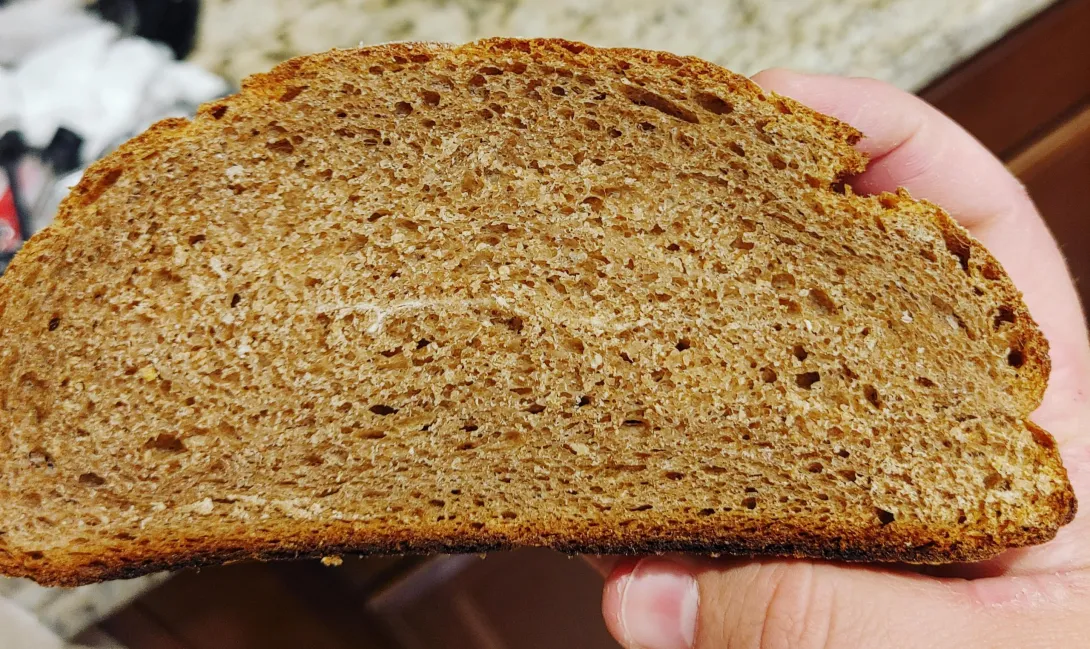
Well I need some help. I mill my own flour (currently by hand). I am having trouble getting a good rise and oven spring out of my sourdough. Here is my bakers percentages.
100% flour
80% hydration
23% starter
3% salt
I am relatively new to sourdough baking and gave never gotten that big open crumb. But I am hardly getting any oven spring on my last few bakes.
Is that picture your "pancake loaf"? That's not a pancake, that's beautiful! Are you only using your own freshly milled whole wheat flour? I think the results are great then. For open crumb you need a lot of white bread flour, not whole wheat flour.
I agree with Ilya, there is nothing pancake about that loaf. I also agree that if that is 100% whole grain then that crumb is quite expected and quite nice. My only comment would be that if you use a dusting of flour when you’re doing final shaping, try to use a bit less and try to brush off excess on the parts of the dough that will end up on the inside of your loaf. I believe I can see a line of raw white flour in the center of the loaf horizontally.
Benny
What kind of wheat are you milling? The wheat characteristics can be what you are dealing with. Have you tried a gentle reshape after proofing but right before going into the oven. Have you ever tried using a pan? It could be that this wheat does better with support.
Lovely loaf! Beautiful color and crumb! I would prefer less salt.
This loaf was made with 75% Hard Red and 25% Hard White and my starter is 50-50 Hard white and Rye
Thank you all for the wonderful comments. I will have to use less flour for dusting as the four got on my bread knife when I opened the loaf resulting in the crumb you see. I had not realized this is what I should expect from whole wheat. I will have to try mixing in some of my sifted "all-purpose" flour and see if that changes the results much. I am also going to try another pre-shape before baking to see if it will hold more shape next time. Thank you all so much!
I agree with everyone that yes, your crumb is typical of a 100% whole wheat bread. But, really really talented bakers can make some wicked 100% whole wheat loaves.
https://www.instagram.com/p/BgTs1Jpl1rq/?hl=en&taken-by=season_adam
season_adam is pretty amazing. His instagram feed has a lot of truly amazing 100% whole grain sourdough loaves, but he doesn't often post the percentages.
https://www.instagram.com/p/B8wGkEwH3au/
1. Welcome to TFL!
2. More hydration would help. I usually use 88-90% hydration with near 100% home-milled WW flour.
3. A soak/autolyse (without starter) could help if you are not already doing that.
4. Less starter could help. around 7% pre-fermented flour works for me for a same day bake. 3.5% if the bulk ferment or the proof goes overnight in the fridge.
5. My experiences/observations with home-milled flour are here: http://www.thefreshloaf.com/node/64863/7-things-about-freshmilled-flour
6. Bon appétit!
Hi, Idaviendy -
I'm a beginner and I have some followup Q for you:
re 3 I thought I'd seen (somewhere) that autolyse wasn't a good thing to do with whole wheat. Or that it needed to be done differently (somehow). But clearly that's not always the case, or it might be plain wrong. Do you have any views on the use of autolyse with white vs whole wheat flours?
re 4 what is the advantage of using less pre-fermented flour? could you comment a bit on how this works?
thanks!
Hi M.G.: I meant autolyse in terms of a pre-soak, with no starter/levain. Pre-soak is the more correct term. (Because so many bread cookbook authors include the levain in the autolyse.)
If you are using home-milled WW flour, I think your questions are answered here: http://www.thefreshloaf.com/node/64863/7-things-about-freshmilled-flour
My comments above, and that link ( 7-things-about-freshmilled-flour) are intended for home-milled WW, and not store-bought WW. Home-milled flour is a different thing than store-bought WW and needs different treatment.